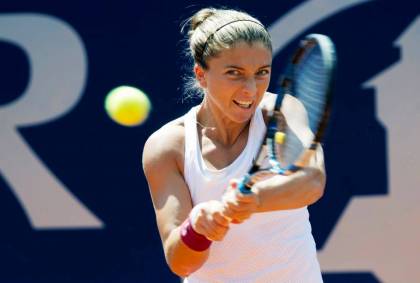World Number 20 Sara Errani rallied from a set down to overcome number 21 Andrea Petkovic with 3-6 6-3 6-2 after two hours and two minutes in a match marked by a lot of unforced errors and a lot of breaks of serve. With this win Errani has reached the third round of the China Open WTA Premier Mandatory in Beijing after beating Petra Kvitova and Caroline Garcia in the previous two rounds.
Errani broke serve on Petkovic’s first service game before holding her serve in the second and the fourth games to take a 3-1 lead but the German reeled off five consecutive games to clinch the first set with 6-3.
Petkovic did not convert a break point in the first game of the second set with two unforced errors but she broke serve to love two games later for 2-1. Errani broke straight back as Petkovic sent her backhand into the net before taking the 3-2 as the German his her forehand wide. Errani got the break in the 8th game before holding her serve to love in the next game. Errani sealed the win in the second set with 6-3 as Petkovic hit her return into the net.
The third set started with three breaks of serve in the first three service games. Errani reeled off four consecutive games from 3-3 in the second set to build a 6-3 1-0 lead with a break of serve in the first game of the third set. Petkovic broke straight back but she dropped her serve again to trail 1-2 as she made two consecutive double faults and sent a forehand wide. Petkovic broke straight back for 2-2 but Errani broke again for 3-2 before holding her serve in the sixth game to take a 4-2 lead. Errani pulled away to 5-2 with a new break and served for the match. In a very long final game Petkovic saved three match points at deuce before Errani sealed the third set with 6-2 after 49 minutes on her fourth match point. The Italian had already beaten the German in the third round of the 2015 Roland Garros with 6-3 6-3.
Errani, who is ranked 19th in the Road to Singapore, has still a small chance to qualify for the WTA Finals but she would need to win the Beijing tournament and defend her position in one of the tournaments after Beijing (Tjanjin, Hong Kong, Linz, Moscow and Luxemburg).
The 28-year-old Italian player will face the winner of the match between Timea Bacsinszky and Carla Suarez Navarro. For the first time in a Premier Mandatory Tournament three Italian players have reached the third round. Tomorrow US Open champion Flavia Pennetta will play against Anastasya Pavlyuchenkova, while Roberta Vinci will face Bethanie Mattek Sands
Number-5 seed Garbine Muguruza is one match away from qualifying for the WTA Finals in Singapore after cruising to 6-2 6-1 over US qualifier Irina Falconi in her opening match in the Chinese capital.
Muguruza, who finished runner-up to Venus Williams last week in Wuhan, built up a 6-2 4-0 lead by reeling off eight consecutive games from 2-2 in the first set en route to closing out the match with 6-2 6-1. If Muguruza wins her next match, she will become the first Spanish player to qualify for the WTA FInals since Aranxta Sanchez Valero in 2001
Muguruza will face Mirjana Lucic Baroni. They are tied 1-1 in their previous two head-to-head matches. In their last match earlier this year Muguruza beat the Croatian player en route to reaching the Wimbledon final. Lucic Baroni beat Muguruza at last year’s US Open.
“I am happy. I tried to keep the level I had in Wuhan and Tokyo. It was hard because I didn’t play for two days and here the conditions are not the same, so I am happy. I didn’t know that I was one win away from Singapore. I knew obviously if I did a great tournament here, I would qualify for the WTA Finals but I didn’t know which round it was. That’s a very good motivation. I want to finish the year in a good year. I want to on holiday and say: “Look. I had a great year. I did everything I could to go off the court feeling that I gave it all my effort”, said Muguruza.






